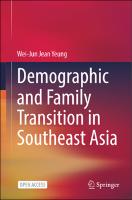Demographic and Family Transition in Southeast Asia
Abstract
This open access book presents the trends and patterns of demographic and family changes from all eleven countries in the region for the past 50 years. The rich data are coupled with historical, cultural and policy background to facilitate an understanding of the changes that families in Southeast Asia have been going through. The book is structured into two parts. Part A includes three segments preceded by a briefing on Southeast Asia. The first segment focuses on marital and partnership status in the region, particularly marriage rates, age at marriage, incidence of singlehood, cohabitation, and divorce. The second segment focuses on fertility indicators such as fertility rates (total, age-specific, adolescent), age at childbearing, and childlessness. The third presents information on household structures in the region by examining household sizes, and incidence of one-person households, single-parent families, as well as extended and composite households. Part B presents indicators of children and youth’s well-being.


 Download
Download Web Shop
Web Shop